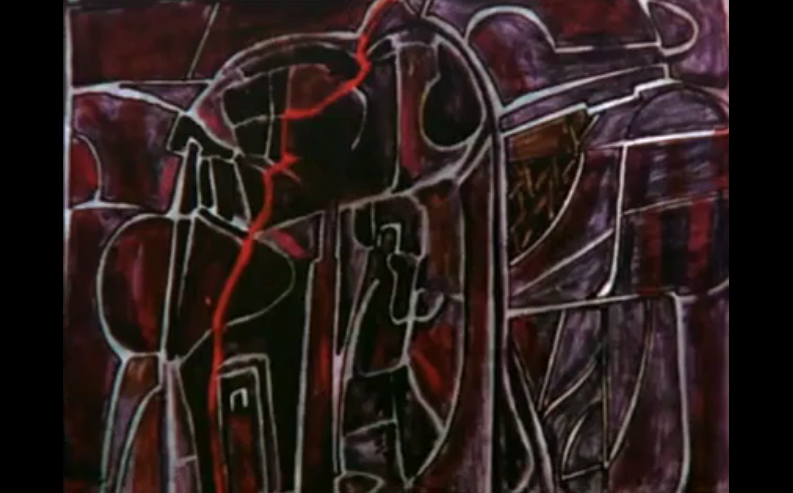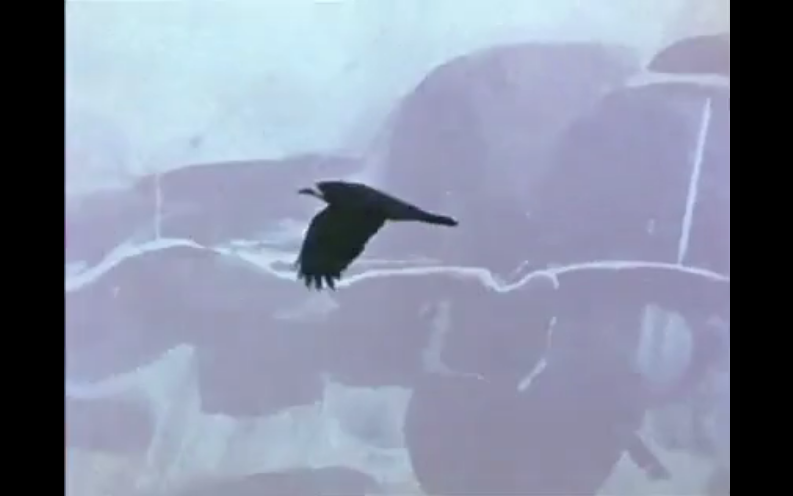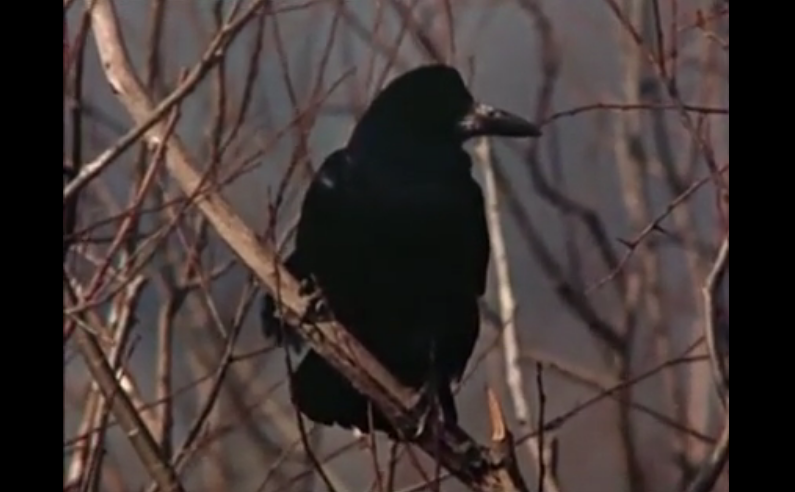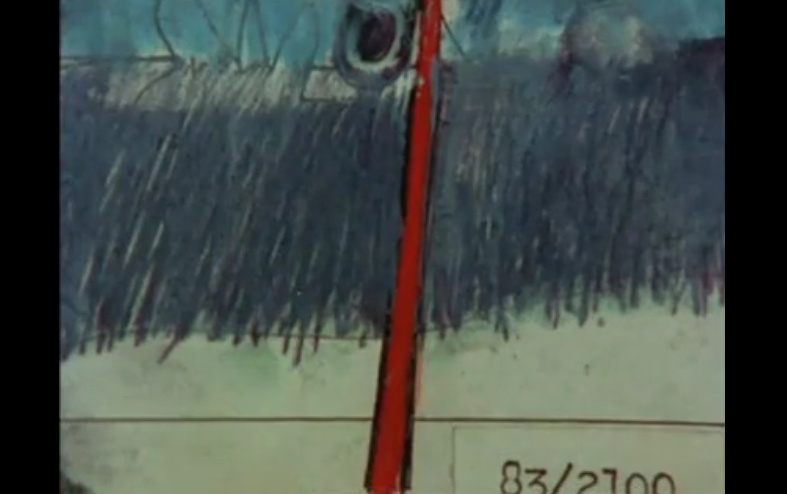Notes on A Walk Through H
Returning readers of this blog will note that we have had previous dealings with the filmmaker Peter Greenaway, to wit, with his 1980 film The Falls (see the entry “The Gulls,” below). The numerous links between his source material for this documentary, his informants, and the Order of the Third Bird surprised none; but in their very profusion they obscured the equally fascinating case of Greenaway’s documentary film of two years prior, A Walk Through H: The Reincarnation of an Ornithologist.
Still from film: route through the city of Contorpis
A Walk Through H is a film that concerns – a film, rather, that fixedly regards – “pictures.” Aside from the initial and closing scenes – where the camera tracks along a corridor toward or away from a room containing framed works – the film never lifts its head or its eyes from the images that so deeply and sinuously preoccupy it. The images themselves greatly vary. At the beginning of the film’s journey, for the most part, they purport to show cities, buildings, and rooms; a red thread traverses these spaces, representing a route to be taken through them, and transforming them into maps.
Crucially, these are routes that have actually been taken through these spaces by the narrator of the film. It is both unstated and beside the point whether he is, in effect, mentally tracing these routes while gazing at the images; whether he carries the pictures on his person and lets them alter his inner experience of a physical landscape he is crossing; or whether indeed he literally enters the pictures in question. It is well known that practitioners of the Order of the Third Bird can have difficulty making such fine distinctions.
Still from film: route through the city of Dormis
What makes this question somewhat more difficult is the fact that it is often the very act of traversing a space, whether in thought or deed, that makes it traversable – a principle that holds even as cities lose their names, rooms lose their walls, and even the yellow (or red) brick road loses its definition.
Still from film
Treating works of art as maps – or simply as enterable things, like windows or doors, or plots of ground to be walked and explored, is not unheard of, particularly for the adepts of the Order. A large collection of documentation within the W-Cache, for example, has to do with musings on and results of such activity, the greatest portion of which is attributable to the secretive, fiercely insular volée of Birds located in the windswept old coastal town of Ipswich in northeastern Massachusetts in the mid-twentieth century. The collection mostly consists of original and reproduction images of houses with large numbers of windows, in a multitude of styles, and includes at least one of the framed works treated in A Journey Through H (see below), which the group conspired to obtain in the early 80s. The group is said to have specialized in a “protocol” of sustained attention inspired by mystical traditions dating ultimately to the first-century Talmudic academies of Asoristan (in Sasanian Mesopotamia), in which a house or palace with many rooms, wings, and floors is traversed in the mind.
Still from film (original acquired by Ipswich MA volée of the Order of the Third Bird in 1982)
It is but a short step, of course, to treating any image – not just architectural images – as houses with many rooms, and this is in fact what occurs with Greenaway’s narrator-traveler as he progresses. Many other Birds, believing that focused attention can best be described as a kind of controlled wandering, an orbit – sometimes wild and electron-like – around a given thing, instead of a discipline nakedly forced upon a single point, have used congruent or convergent techniques. The Greenaway film alludes to these currents of Bird practice via the device of having each “picture” or map, once used, gradually fade and be replaced by an odd symbol that resembles “a signpost or the skeleton of a windmill.”
Another line in the film’s voiceover alludes to an equally important ongoing debate in the Order. “Were other travelers,” asks the narrator, in Colin Cantlie’s brisk voice, “obliged to travel through the same country?” Perhaps, he continues, “it was not impossible that other travelers had different maps of this territory, simpler and more straightforward maps.”
Still from film
Works of art, of course, accommodate as many journeys as there are journeyers, even though details of these journeys often uncannily coincide. In fact, there exist theories that the work of art is a single, unchanging locus, but so richly endowed with potential configurations and trajectories of experience that it may as well be a different thing, in a different place, for every person who encounters it (this is not the same as saying that the work of art is redefined by every new encounter with it.) There are also theories, it must be mentioned, according to which all existing works of art are partial maps of the terrain of a single alternative universe, over the surface of which Birds endlessly travel, leaving their minute, whorled, flocking trails with every collective Action of sustained attention.
Still from film
It takes very little to see that Greenaway’s film hints quite heavily in the direction of the Order. This raises a question, however – a question also raised by The Falls of 1980 – of what the great filmmaker stood to gain or to say from working the Order into this document of a singular journey.
One clue lies in the fact that many of the purported “maps” for this journey are layered over or cut with images of birds in flight. In some of these images, birds fly against the background of the tangled branches of winter trees, which resemble the tangled paths of the maps; their winged bodies form abstract ciphers that often strikingly resemble the “windmills” mentioned above.
It must be stated that there are two kinds of “windmill” in A Walk Through H. There are, first of all, the windmills that replace the maps once they inevitably fade, after use (below, left); then there are the shapes that increasingly, troublingly proliferate upon the maps as the film progresses, functioning both as guides and as obstacles (below, left).
Though Greenaway in no way directly indicates that the windmills are birds (indeed, the reader might object that windmills are often quite hazardous to birds), the insinuations in this direction are forcefully underlined toward the end of the film, where a book by the great traveler and ornithologist Tulse Luper, titled Birds of the Northern Hemisphere, makes its appearance. Here the comparison, as it were, flies in the face like birds flushed from the bush.
If these windmills, of both kinds – implacable, silent, inscrutable – are indeed birds, a number of questions arise. Why, really, do the maps, once used, fade to be replaced by birds? Does this represent an intervention in debates about the nature of attention, as suggested above, or some kind of comforting affirmation, or strict prohibition, or instead something more sinister? Why do these sigils so contagiously proliferate as the film nears its ambiguous denouement? Why would images of birds be so insistently used to counterpose freedom and unfreedom, passageways and barriers, the joy of flight and the despair of those lost in a maze? Greenaway’s troubled, ambivalent relationship with the Order, at the very least, is in full evidence here.
Further mysteries linger. One of the images displayed in the film bears the figure “83/2100.” It just so happens that the W-Cache contains, in one of its ubiquitous file boxes – labeled “Telegnomy,” for reasons as yet unexamined by our researchers – a sequence of 2100 images, in varying sizes and media, bearing seemingly unrelated content. From this sequence, a single image is missing: number 83. The question of whether the formation of this W-Cache collection predates the filming of A Walk Through H would thus be of the greatest possible significance with regard both to Greenaway’s history with the Order and to the history of the Order itself.
Though perhaps here we are making a mountain out of a mere numerical coincidence – a human error among the many to which we cannot be considered immune – it is certainly no coincidence that an image of one of the “cities” in the film, called Antilipe (supposedly located in Syria), quite clearly shows an Action of the Order taking place.
Still from film: an Action of the Order of the Third Bird taking place in the “city” of Antilipe (Syria).
Note the four Birds at center and the two bird-sigils at bottom left and right.
What manner of Protocol, what esoteric lineage of practice, might this strange image reveal? Did Peter Greenaway, at some point in his life, encounter the fabled Syrian Order of Birds (now familiar to our readers from a number of recent and groundbreaking ESTAR(SER) publications) – and find himself transformed by this encounter? Was his life altered by an experience that was both as sharply defined and as nameless and fleeting as – to use the film’s words – “a path made across the grass by the shadow of flying birds”?















